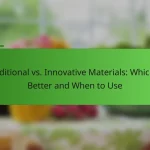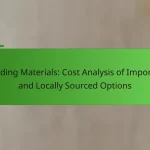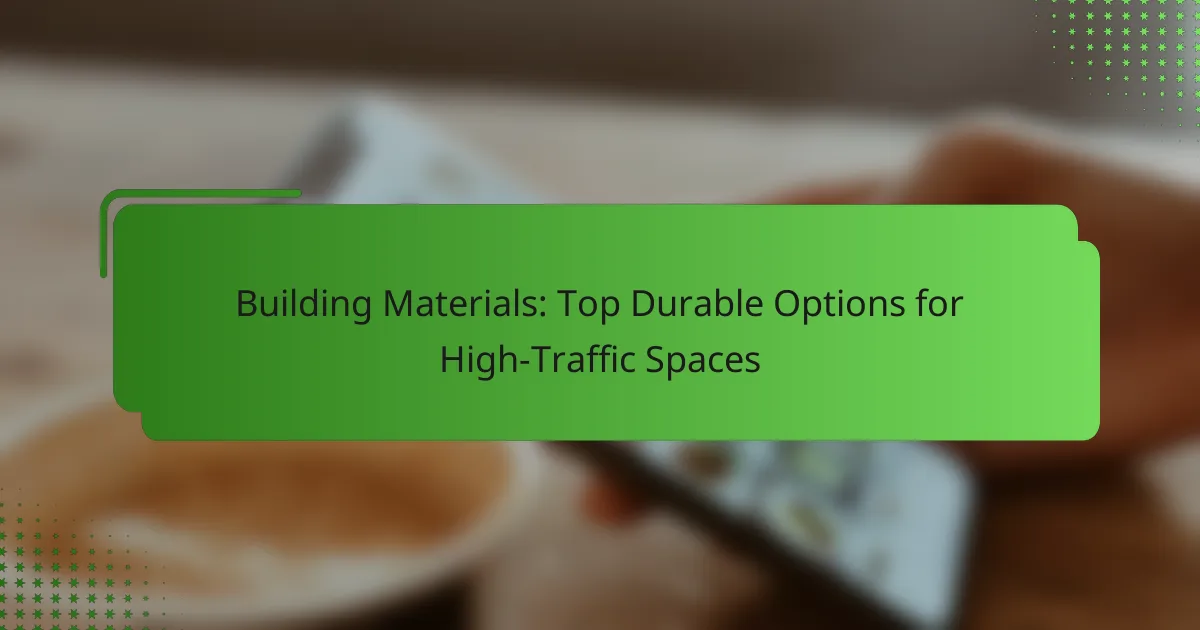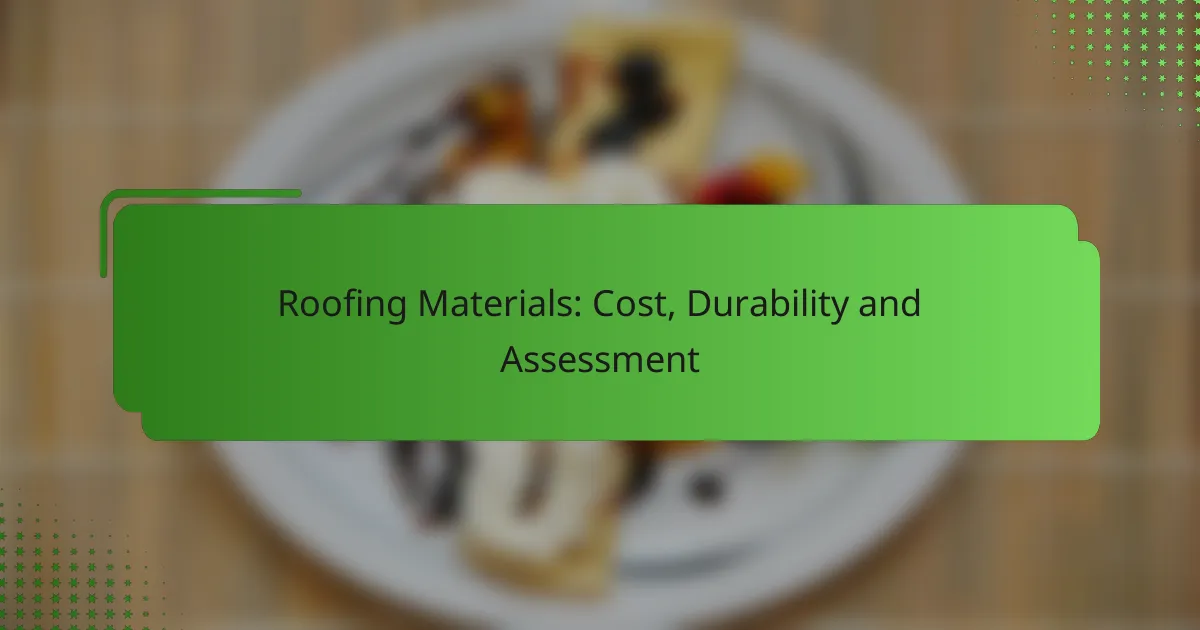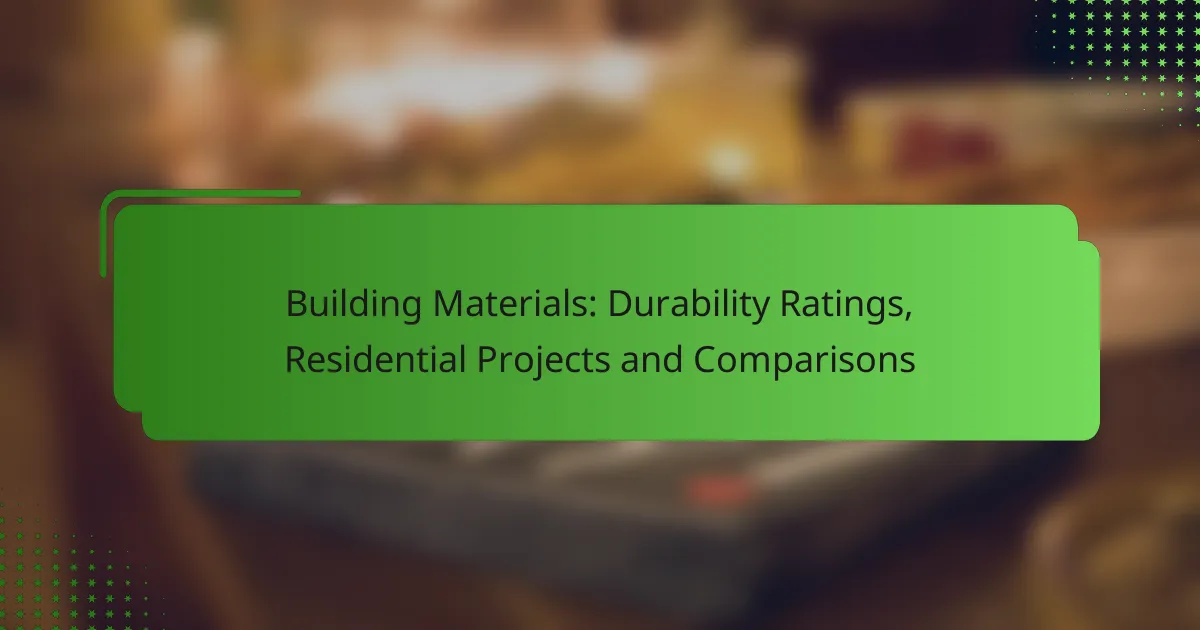When selecting building materials for high-traffic spaces, durability and maintenance are key factors to consider. Options like porcelain tiles and vinyl flooring not only withstand heavy foot traffic but also offer resistance to scratches and moisture, ensuring they remain visually appealing over time. Choosing the right materials can enhance both the functionality and aesthetics of busy environments.
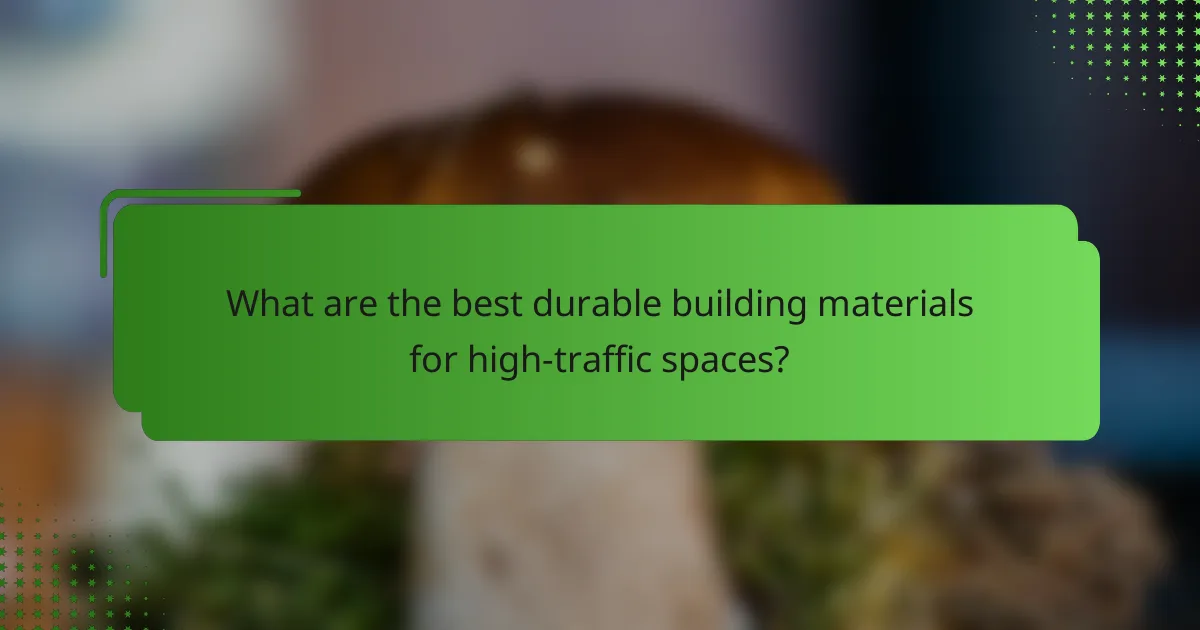
What are the best durable building materials for high-traffic spaces?
The best durable building materials for high-traffic spaces include options that withstand wear and tear while maintaining aesthetic appeal. Key considerations include resistance to scratches, moisture, and ease of maintenance.
Porcelain tiles
Porcelain tiles are an excellent choice for high-traffic areas due to their density and low porosity, making them resistant to moisture and stains. They come in various styles, allowing for versatility in design while providing durability.
When selecting porcelain tiles, look for options rated for commercial use, as these will offer enhanced durability. Regular cleaning with mild detergents can help maintain their appearance over time.
Vinyl flooring
Vinyl flooring is a cost-effective and resilient option for high-traffic spaces. It is available in sheets, tiles, or planks, and offers a wide range of designs, including those that mimic natural materials.
Consider choosing luxury vinyl tiles (LVT) for added durability and comfort underfoot. Ensure proper installation to avoid issues with seams and edges, which can wear down more quickly in busy areas.
Concrete
Concrete is one of the most durable materials available for high-traffic areas, known for its strength and longevity. It can be stained or polished to enhance its appearance, making it suitable for both industrial and residential settings.
To prevent cracking, consider using a concrete sealer and ensuring proper curing during installation. Regular maintenance, such as resealing every few years, will help extend its lifespan.
Natural stone
Natural stone, such as granite or slate, offers a unique aesthetic and exceptional durability for high-traffic spaces. Its natural variations provide a distinctive look, while its hardness makes it resistant to scratches and wear.
However, natural stone can be porous, so applying a sealant is crucial to prevent staining. Regular cleaning with pH-neutral products will help maintain its beauty and integrity.
Engineered wood
Engineered wood combines the beauty of hardwood with enhanced durability, making it suitable for high-traffic areas. It consists of a top layer of real wood over layers of plywood, providing stability and resistance to moisture.
Choose products with a thicker wear layer for better performance in busy spaces. Regular maintenance, including cleaning with appropriate wood floor cleaners, will help preserve its finish and longevity.

How do porcelain tiles perform in high-traffic areas?
Porcelain tiles are highly durable and well-suited for high-traffic areas due to their strength and resistance to wear. They can withstand heavy foot traffic, making them a popular choice for commercial spaces, entryways, and busy households.
Scratch resistance
Porcelain tiles are known for their excellent scratch resistance, which is crucial in high-traffic environments. The dense composition of porcelain makes it less susceptible to scratches compared to softer materials like vinyl or natural stone.
When selecting porcelain tiles, look for options with a PEI (Porcelain Enamel Institute) rating of 4 or 5, indicating high durability against scratching. This ensures that the tiles will maintain their appearance even in busy areas.
Water resistance
Porcelain tiles offer superior water resistance, making them ideal for areas prone to spills or moisture, such as kitchens and bathrooms. Their low porosity prevents water absorption, reducing the risk of mold and mildew.
To maximize water resistance, ensure that the tiles are properly sealed and installed with appropriate grout. This will help maintain their integrity and appearance over time.
Maintenance requirements
Maintaining porcelain tiles is relatively straightforward, requiring regular sweeping and occasional mopping with a mild detergent. Their resistance to stains and moisture means that they do not need extensive upkeep compared to other flooring options.
Avoid harsh chemicals that can damage the surface. Instead, use pH-neutral cleaners to preserve the tiles’ finish. Regular maintenance will keep the tiles looking new and extend their lifespan in high-traffic areas.

What are the benefits of using vinyl flooring?
Vinyl flooring offers several advantages, particularly for high-traffic spaces. It is durable, easy to maintain, and resistant to moisture, making it an ideal choice for both residential and commercial environments.
Cost-effectiveness
Vinyl flooring is often more affordable than other flooring options like hardwood or tile. Prices typically range from $2 to $7 per square foot, depending on the quality and design. This cost-effectiveness makes it a popular choice for budget-conscious homeowners and businesses.
Additionally, the installation process for vinyl is generally simpler and quicker, which can further reduce labor costs. Many vinyl products are designed for DIY installation, allowing you to save on professional services.
Variety of designs
Vinyl flooring comes in a wide array of designs, colors, and textures, allowing for customization to suit any aesthetic. It can mimic the appearance of natural materials like wood or stone, providing a stylish look without the associated costs and maintenance.
With advancements in printing technology, vinyl designs have become increasingly realistic, making it a versatile option for various interior styles. Whether you prefer a modern, rustic, or traditional look, there is likely a vinyl option that fits your vision.
Comfort underfoot
Vinyl flooring is known for its comfort, offering a softer surface compared to harder materials like tile or laminate. This can be particularly beneficial in high-traffic areas where people spend a lot of time standing, such as kitchens or retail spaces.
Many vinyl products also come with added cushioning layers, enhancing comfort and reducing fatigue. This feature makes vinyl a practical choice for both residential and commercial settings, where foot traffic is high and comfort is a priority.

How does concrete compare to other materials?
Concrete is often favored for high-traffic spaces due to its strength and longevity, outperforming many other building materials in durability and maintenance. While options like wood or tile may offer aesthetic benefits, they typically require more upkeep and may not withstand heavy use as effectively as concrete.
Durability
Concrete is renowned for its exceptional durability, making it ideal for high-traffic areas such as commercial buildings, warehouses, and public spaces. It can resist wear, impact, and weathering, often lasting several decades with minimal maintenance. In contrast, materials like wood can warp or degrade over time, especially in humid environments.
To ensure maximum durability, consider using reinforced concrete, which incorporates steel bars or mesh to enhance strength. Regular sealing can also protect against stains and moisture, extending the lifespan of concrete surfaces.
Customization options
Concrete offers a wide range of customization options, allowing for various finishes, colors, and textures. Techniques such as stamping, staining, or polishing can create visually appealing surfaces that mimic natural stone or tile. This versatility makes concrete suitable for both functional and aesthetic applications.
However, customization may increase initial costs and installation time. It’s essential to work with experienced contractors who can provide quality finishes while maintaining the structural integrity of the material.
Environmental impact
The environmental impact of concrete is a significant consideration, as its production is energy-intensive and contributes to carbon emissions. However, advancements in technology are leading to more sustainable practices, such as using recycled materials or alternative binders that reduce the carbon footprint.
When evaluating concrete for a project, consider sourcing materials locally to minimize transportation emissions. Additionally, look for certifications like LEED or similar standards that indicate environmentally responsible practices in concrete production and installation.

What should you consider when selecting building materials?
When selecting building materials for high-traffic spaces, consider durability, maintenance, and suitability for the specific environment. The right materials will withstand wear and tear while maintaining aesthetic appeal and safety.
Traffic volume
Traffic volume directly influences the choice of building materials. High-traffic areas, such as commercial entrances or hallways, require materials that can endure constant use without significant wear.
For instance, flooring options like porcelain tiles or high-quality vinyl are often recommended for their resilience. In contrast, softer materials like carpet may not be suitable in these settings due to their tendency to show wear quickly.
Climate conditions
Climate conditions play a crucial role in determining the longevity of building materials. In areas with extreme temperatures or high humidity, materials must be selected for their ability to resist damage from moisture, heat, or cold.
For example, in humid climates, materials like treated wood or composite decking can help prevent rot and mold. Conversely, in colder regions, insulation properties and frost resistance become vital, making materials like concrete or stone more favorable.

